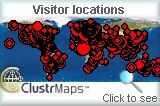VeekTheVote 2006: Mobile Communications Success
Veeker (www.veeker.com), a leading mobile-to-Internet video communication service, believes that the mobile phone as a video capture and communication device had its coming out party during this year’s U.S. election.
“Veek the Vote 2006,” which received over 750 mobile video messages from Americans using the video camera in a mobile phone to show the world where they stood on Election Day, represents a new milestone for citizen journalism in the United States. “Veek the Vote 2006” was the result of a partnership between Veeker and YouthNoise (www.youthnoise.com), the Internet’s first social network for youth dedicated to social change.
"I appreciate the work that activists from across the country, like those on VeekTheVote.com, have done to identify existing problems, and to help protect the rights that we all enjoy," states recently re-elected U.S. Representative Lynn Woolsey (D-CA) about Veek the Vote 2006.
On Election Day, mobile video messages and photos arrived every few minutes from various states across the nation, including Virginia, Missouri, California, Pennsylvania, New York, New Jersey, Tennessee, Florida and Ohio. In local races, one video message showed San Francisco School Board candidate Jane Kim making the rounds with her campaign posters. On a state and national level, there was a ‘VEEK’ of a Claire McCaskill supporter participating in a ‘Get out the Vote’ initiative. McCaskill eventually won this particular race by a small margin and contributing to the Democratic parties’ eventual control of Senate by majority.
Other video messages were from YouthNoise’s CitiJo (i.e., Citizen Journalist) NOISEmakers who were reporting on the most important issues this election. News of “Veek the Vote 2006” spread through the political blogosphere, further demonstrating the impact of the blogging community in this election.
“College kids and senior citizens alike joined together to use the cameras in their mobile phones to communicate their experiences and opinions on Election Day,” states Veeker Co-Founder Rodger Raderman. “People felt empowered by the ability to express themselves in this way to other Americans. Taken together, all of these videos present a richly textured view of Election Day in America.”
The history of mobile video capture has evolved globally from a first look media capture of tragic events to an effective tool for citizen journalism.
According to a November 2007 Gartner Research Report, worldwide sales of camera phones will account for 48 percent of total worldwide mobile phone sales in 2006 and grow to 81 percent by 2010. Additionally worldwide sales of camera phones, which have almost tripled since 2004, will reach 460 million in 2006, an increase of 43 percent from 2005. This trend is set to continue, leading to sales of one billion camera phones by 2010.
In an October 2007 study, the research firm Telephia reported over eight million U.S. handset owners have captured video on their mobile phones. This marks an upward trend for mobile video as a communication tool as a November 9th Wirefly survey found that 68% of cell phone users rate the camera as their favorite cell phone feature.
“Already, one quarter of the cell phones shipped in North America this year have camcorder capabilities and consumers are increasingly experimenting with this new form of self-expression. This is the perfect time for services like Veeker’s to hit the market with simple and free solutions for people to upload and share mobile content. Previous to these types of services, many Americans captured content and then didn’t know what to do with it,” states Jill Aldort, Senior Analyst, Consumer Mobility Applications, Yankee Group.
Disclaimer: The poster is a former Regional Field Director of Rock The Vote and a current consultant for Veeker.
| Attachment | Size |
|---|---|
| veekerlogo.jpg | 165.99 KB |

